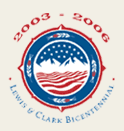The Science of Lewis & Clark
"It is astounding that the expedition is rarely discussed in terms of its scientific achievements, for the Lewis and Clark Expedition was one of the first systematic scientific evaluations of a region ever conducted."
- Excerpt from the Jefferson National Expansion Memorial's
The Lewis & Clark Journey of Discovery Website
Listed below is a sampling of web-based resources focusing on the science of the Lewis & Clark Expedition:
Smithsonian National Museum of Natural History website: Lewis and Clark as Naturalists
Follow the Lewis and Clark trail and discover the flora and fauna as they described it along the way. You can either choose the interactive map, or browse the collection by category.
The Library of Congress: Science Reference Services
Books, articles and websites on 'The Natural History of Lewis and Clark.'
Links to USGS Science along the Lewis and Clark Trail
The USGS serves the nation as an independent fact-finding agency that provides scientific understanding about natural-resource conditions, issues, and problems.
The Academy of Natural Sciences: The Herbarium
Established in 1812 in Philadelphia "for the encouragement and cultivation of the sciences, and the advancement of useful learning," the Academy continues to nurture scientific discovery almost two centuries later. Included in the Herbarium collection are the vast majority of specimens collected in the American Northwest by Lewis and Clark.
University of Cincinnati's: Botany Of The Lewis & Clark Expedition
This exhibit presents 31 plants collected during the expedition. They are illustrated with specimens from the Margaret H. Fulford Herbarium at the University of Cincinnati and photographs taken primarily by Victor Soukup, Curator of the Herbarium Collection. The location where Lewis collected each specimen is identified on the map from the edition of the journals published in 1814.
The Oregonian: The Legacy Grows - Lewis & Clarks Garden
This special issue of HOMES & GARDENS of the Northwest, published by the Oregonian and hosted on the NWREL site, focuses on the 176 plants Meriwether Lewis and William Clark discovered for science.
Harvard's Peabody Museum of Archaeology & Ethnography: The Ethnography of Lewis & Clark
This online exhibit highlights recent research, conducted by the Peabody, into some sixty objects that that may be linked to the Lewis and Clark expedition. These include six objects that are firmly associated with the expedition, and more that have varying degrees of documentation.
Carnegie Museum of Natural History: The Natural History of the Lewis & Clark Corps of Discovery
Each description of an animal on this site is the first mention of that animal in the journals of Lewis and Clark. The site was developed in conjunction with the museum's exhibit 'Corps of Discovery: The Natural History of the Lewis and Clark Expedition.'
ABC News: Weather Made Lewis and Clark's Trek Successful
A study finds Lewis and Clark could have met dire weather. If Meriwether Lewis and William Clark had set off on their historic expedition across what is now the northwestern United States a few years earlier, or a couple of years later, the dream of then-President Thomas Jefferson might have turned into a nightmare.
NOAA 200th Feature Stories: Lewis and Clark: Pioneers in Meteorology
A review of the historical records and journals of the era by two NOAA scientists revealed that meteorological data and personal weather-related observations collected by these pioneering weather observers (Lewis & Clark) are worthy of celebration.
Greening, G. K. Climatic conditions in the Louisiana Purchase as found by Lewis and Clark in 1804 and 1805. Monthly Weather Review. August 1930, (58) 8. pp. 317–319.


